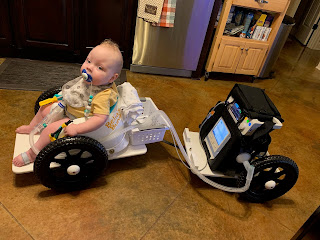Asher Taylor is an 18-month old full of joy and inspiration. When Asher's mom Christie was 19 weeks pregnant with him, she found out that Asher had spina bifida myelomeningocele. Spina bifida meylomeningocele is a neural defect where the spinal cord does not close completely, and the spinal cord and meninges protrude from the back. Unfortunately, Christie was not able to have fetal surgery to correct Asher's spinal cord, so he had surgery to close the lesion within 48 hours after he was born.
Asher was born with hind brain and mid brain defects. At birth, he also experienced severe hydrocephalus, and his cerebellum was descended into his spinal canal. As a result, after ~4 weeks of Asher being born, he had a shunt placed to relieve pressure on his brain. About a week later, Asher began choking and aspirating. About 10 days post-shunt, all the pressure went to Asher's head, and Asher struggled to breathe. He became unresponsive, and the doctors thought it was respiratory syncytial virus, which severely affected Asher since he was immunocompromised from his birth defect. The doctors scoped Asher and found out that his vocal cords were not moving correctly and that Asher had sensory deficits. As a result, Asher underwent a tracheostomy, which inserted a tracheostomy tube to Asher's trachea to help his respiration. He also had a gastrostomy tube (G-tube) placed in his belly to get nutrients to his stomach.
However, Asher still did not improve. As a result, Asher underwent Chiari II decompression surgery. The doctors removed part of the back of his skull and his first three cervical vertebrae to provide space for his abnormally positioned brainstem.
Asher is currently diagnosed with symptomatic chiari malformation, which means that his cerebellum is still in his spinal canal. He also has two large syringes, which are large fluid sacs, on his spine. He is at risk for a spinal shunt and VP shunt, which takes excess fluid from the brain to the abdomen where it is absorbed by the body. He could potentially have more decompression surgeries in the future, but he is currently medically stable and participates in physical therapy and occupational therapy weekly.
Asher's lesion occurred around T4/T5/S1, so he experiences sensory deficits on his thigh and buttocks. As a result, Asher will probably not be able to independently walk. Asher will never have complete control of his bowel and bladder, so he is catheterized every four hours. Asher will more than likely have a tracheostomy tube throughout his lifespan to aid in breathing and swallowing. When Asher goes to sleep, his autonomic systems stops working, and he experiences central apnea (he stops breathing when he sleeps). Therefore, he his on a ventilator when he sleeps.
Despite his deficits, Asher is defying all odds. He is cognitively intact and engages with his environment. He understands the concept of being spoken to and understands the "cause-and-effect" relationship. He is a very social little boy, so when he wants his parents' attention, he knows that pulling his G-tube out will get the job done.
Asher's problem-solving skills are progressing. Unfortunately, he still experiences low tone, especially in the abdomen. However, recently, he flipped on his back from the sitting position, and he figured out how to sit back up by leaning to the side and using his hands to walk himself back up to the sitting position.. When Asher is in the car, he has a little mobile with toys hanging down. He is unable to reach the toys with his arms, so he takes his circuit off and waves it like a wand to play with the toys.
Asher loves interacting with his big brothers and parents. He recognizes people and his nurses. He is not shy and loves to socialize with people. The family recently adopted a new dog, and Asher loves playing with the dog.
The family hopes Asher will be able to eventually walk with an upper extremity walker and/or AFO braces. Sadly, insurance will not pay for a wheelchair until Asher is 4 years old. However, there is a family in New York who also has a child with spina bifida. They make adaptable wheelchairs for babies with spina bifida and give it to those children for free. Asher has been lucky enough to receive one of those specialized wheelchairs.
The wheelchair has support for Asher's trunk, and it allows Asher to ambulate around the house. There is a bucket behind the chair and another tray attached to the back to carry all of Asher's equipment. With this awesome device, Asher can play with his brothers and parents and explore his environment as much as he wants.
Asher is the epitome of inspiration. At just 18 months, he is defying all the odds of his health deficits and still learning to live a full, active life. Despite all his challenges, Asher is such a joyful little boy who makes everyone smile. He lights up the room wherever he goes and is always the life of the party. He encourages me daily to face any obstacles thrown my way.









